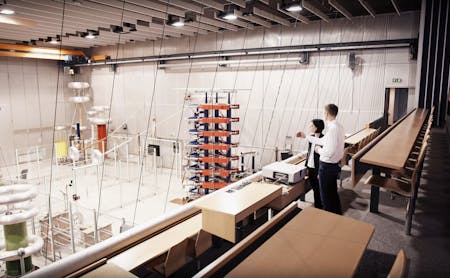The energy reform poses new challenges for the Swiss electricity grid. In-depth research and development work is needed to prepare the transmission grid for the future. Swissgrid cooperates with universities to develop the new technologies and methods required to enable the efficient and secure transmission of energy.
The expansion and modernisation of the Swiss electricity grid is one of Swissgrid's most important tasks. It is vital to ensure that Switzerland continues to have a secure supply of electricity in the future.
Therefore, we’re looking for bright minds. Swissgrid supports research projects, theses and offers internships. We are interested in research on the following topics:
- Automation/digitalisation in system operations and in asset management
- New technologies/methods for energy transmission
- Ensuring the stability of the grid
- Increasing public acceptance for grid projects (modernisation and expansion)
Equigy
In future, electricity generation will become less flexible and more difficult to predict due to the increase in new renewable energy resources, such as solar and wind power. This development presents challenges for transmission system operators, who need to ensure a balance between production and consumption.
With the crowd balancing platform «Equigy», Swissgrid has launched a pilot project in Switzerland that targets the use of storage technologies in the area of primary control energy. The goal of the project is to balance short-term fluctuations in the transmission grid with the support of small decentralised energy sources, such as energy storage systems, electric cars, battery storage devices and heat pumping technology.
TSO-DSO Coordination
Resources such as photovoltaics, heat pumps or charging stations for electric vehicles known as «decentralised energy resources» are spreading rapidly. They are positive for bringing about a sustainable energy transition but pose challenges at all levels of the transmission and distribution grid. For example, they can lead to localised congestion, voltage violations or imbalances between electricity generation and consumption throughout the entire system.
Decentralised resources are becoming increasingly important for Swissgrid
The «TSO-DSO Coordination (TDC)» project demonstrates in a practical way how decentralised flexibility can be used to benefit the grid. Resources such as batteries, heat pumps and charging stations are controlled so that they can respond to the changing demands of the grid. Flexibility service providers offer this flexibility by storing, consuming or feeding energy into the grid – depending on what is best for grid stability and efficiency. Swissgrid is working with industry partners to drive forward this innovation project, which is now entering the test phase.
What has been achieved in the current Phase B?
Axpo, Azienda Elettrica di Massagno (AEM), CKW, ewz, Groupe E, Primeo Energie, Romande Energie, St.Galler Stadtwerke (sgsw) and Swissgrid worked together on TSO-DSO Coordination Phase B from 2023 until December 2024, enhancing the coordination concept from the initial Phase A.
The current concept includes considerations on market and product design and on potential business models for the development and operation of the coordination mechanism. In addition, a legal and regulatory analysis has been carried out and a rough implementation schedule drawn up. The designed coordination mechanism enables transmission and distribution system operators to procure ancillary and grid services in an efficient, scalable and grid-secure way. In a market-based design, the flexibility of distributed energy resources is offered by flexibility service providers and used for the most valuable purpose at each point in time. Furthermore, the design considers current market developments as well as the legal and regulatory framework in Switzerland and in Europe.
Next steps and outlook
The upcoming Phase C will test the coordination concept with simulations and a pilot focusing on DSO processes, complemented by a study of the market potential in Switzerland.
3D Decision Support System
Where will a new line run? Which area is suitable, which less so? The 3D Decision Support System project developed by ETH Zurich aims to answer these questions and find the line route that is most widely accepted by the stakeholders.
To do so, the system considers the interests of the parties affected and provides a three-dimensional view of the different solutions.
In this way, the 3D Decision Support System greatly facilitates the planning of lines and makes project planning more efficient and transparent. Swissgrid uses the system to erect new lines.
Dynamic Line Rating
The maximum temperature of the conductor cable indicates how much current can flow along a line with-out overloading it or causing excessive sag, in the worst case scenario resulting in contact with the ground or trees.
Up to now, just three static seasonal values for ambient temperature have been used in the extra-high-voltage grid to determine the maximum permitted intensity of current. These figures often differ from the actual climate situation, and weather conditions can vary a great deal from region to region.
Tests are now being carried out with Dynamic Line Rating using real-time measurement data and microcli-matic weather forecasts to improve the modelling of interdependencies between weather conditions, con-ductor temperature and intensity of current. Meters mounted directly on the conductor cable continuously determine the intensity of current, temperature, angle of inclination and acceleration. The maximum elec-tricity volume that can flow through the conductor cable can be determined flexibly on the basis of this real-time data, combined with local weather forecasts. This enables a more efficient utilisation of the grid infrastructure.
Links
More projects
Drone use for maintenance projects
Occasionally, supporting structures develop corrosion on the inside of pipes. However, paint used to protect against corrosion prevents rust being noticed during visual inspections. This project tests whether corrosion can be discovered using an automated process that employs drones. Such processes increase safety. Lines do not need to be switched off, and engineers are not required to inspect systems at a height of 50 metres.
Swissgrid is opting for drone technology for inspecting overhead lines
Swissgrid is now able to use drone technology to detect damage to high-voltage lines more quickly and in a more targeted manner, for example. Autonomous flights and intelligent image analysis make overhead line inspections more precise, safer and more sustainable – progress that saves time and money.
The benefits of automated flight planning at a glance:
- Drones allow preventive screening and can detect damage to overhead lines at an early stage before it becomes critical.
- Predictive maintenance: the status of the grid can be continuously monitored and long-term trends analysed.
- In comparison with ground inspections, drones deliver highly precise and complete image data.
- Less human intervention is needed in areas that are difficult to access, increasing safety.
- Drones are particularly advantageous in mountainous regions because they can negotiate differences in height without any problems and without complex logistics.
- Efficiency can be increased due to continuous process automation.
Flights out of visual range: a milestone for Swissgrid
When a drone flies autonomously, it does so out of the pilot’s visual range. Swissgrid carried out a BVLOS (Beyond Visual Line of Sight) flight for the first time in 2024. BVLOS flights can be used to monitor long distances without direct visual contact – automation is a key advantage for the inspection of high-voltage lines because it enables a significant increase in efficiency. Another innovative aspect is that the drones are equipped with LiDAR sensors (Light Detection and Ranging). Thanks to three-dimensional laser scans, these sensors provide high-precision image data that complements existing helicopter images and will even replace them in the long term. The positive results of the test flights are paving the way for the increased use of autonomous drones in the coming years. This will enable Swissgrid to further optimise its processes for maintaining the transmission grid, drive forward the digitalisation of grid inspections and ensure long-term security of supply on the grid side.
More capacity on transmission lines
The Swiss electricity grid has a number of congestion points. To eliminate these, greater transfer capacity is required. However, the construction of new lines is not always accepted by the parties affected. As an alternative, Swissgrid endeavours to optimise the transfer capacity of existing lines.
The «Hybrid Overhead Lines in Switzerland» research project being carried out by ETH Zurich is investigating the extent to which the combination of direct and alternating current systems increases the transfer capacity of existing 380 kV overhead lines. Calculations show that the capacity of hybrid overhead lines is 50 percent higher than that of conventional lines.
The ETH research project not only considers the technical aspects of the different systems but also evaluates their cost-efficiency and social acceptance.
Energyscape - Focus on the landscape
Wind power plants or transmission lines change the landscape significantly. But what infrastructure fits into which landscape? And to what extent is it accepted by the parties affected? – The ETH «Energyscape» project aims to construct electricity infrastructure where acceptance is greatest. To do so, it creates acoustic/visual simulations of infrastructure in characteristically Swiss landscapes.
Smart Grids
More and more electricity is being produced locally. It primarily comes from renewable sources, such as wind and solar power plants. Production is difficult to plan and is subject to fluctuations.
That's why Smart Grids are needed. They ensure that electricity producers and consumers are in constant communication – and balance fluctuations in production and consumption. In doing so, Smart Grids help to ensure reliable and efficient operation.
An important part of Smart Grids is intelligent measuring systems called Smart Meters. They help save electricity and improve energy efficiency. Intelligent measuring systems are part of the federal government's Energy Strategy 2050.
Data visualisation
For the operation of the transmission grid, more data than ever before is available. The big challenge is making this data of use for decisions in a systematic and timely manner. This project aims to enable faster and better decisions by means of visualisations of data relating to the current system state.
Data Lab
Grid operators work in an incredibly complex and greatly changing environment, in which the volume of data generated is increasing rapidly. When correctly processed and analysed, this data can optimise decision-making and corporate management and offer crucial added value. Swissgrid wants to exploit this potential. After all, increasingly demanding operations and the urgently required modernisation of the grid, as well as society’s calls for greater transparency, require new solutions.
Using data science, it is possible to evaluate and analyse large volumes of data. Data science can now also be used by smaller companies thanks to advancing industrialisation: tools and technologies have developed in recent years in parallel to ever greater computer performance and cheaper data storage and are in many cases available in a user-friendly format, for instance as cloud platforms and cloud services. Swissgrid has already gained experience in the use of data science through a range of pilot projects, and is now aiming to develop this area further.


























